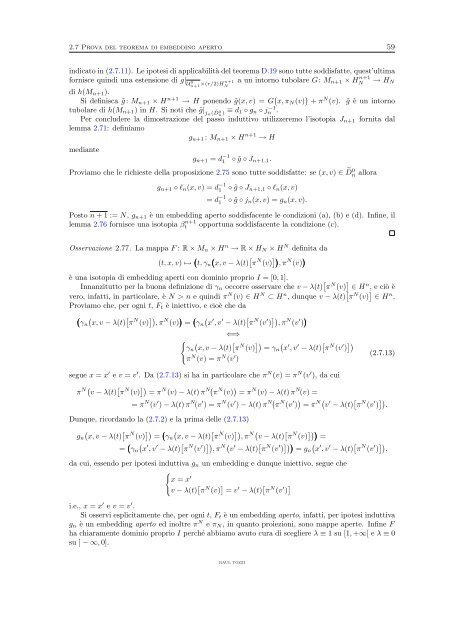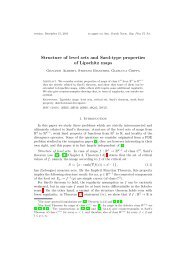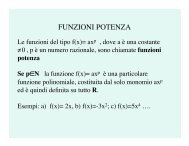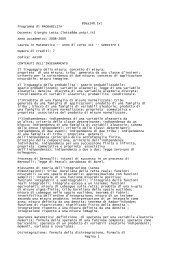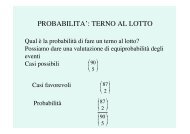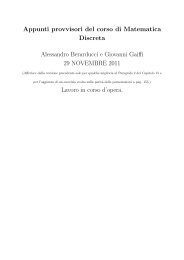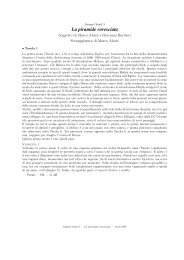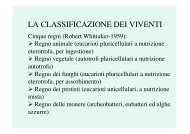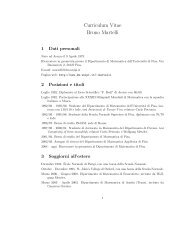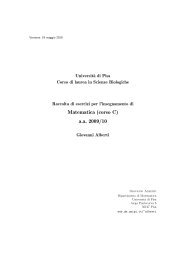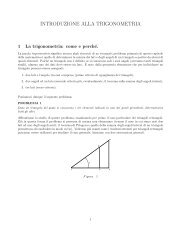Immersioni aperte in dimensione infinita - Dipartimento di Matematica
Immersioni aperte in dimensione infinita - Dipartimento di Matematica
Immersioni aperte in dimensione infinita - Dipartimento di Matematica
Create successful ePaper yourself
Turn your PDF publications into a flip-book with our unique Google optimized e-Paper software.
2.7 Prova del teorema <strong>di</strong> embedd<strong>in</strong>g aperto 59<br />
<strong>in</strong><strong>di</strong>cato <strong>in</strong> (2.7.11). Le ipotesi <strong>di</strong> applicabilità del teorema D.19 sono tutte sod<strong>di</strong>sfatte, quest’ultima<br />
fornisce qu<strong>in</strong><strong>di</strong> una estensione <strong>di</strong> g| U 0 n+1 ×(r/2)H n+1<br />
N<br />
a un <strong>in</strong>torno tubolare G: Mn+1 × H n+1<br />
N<br />
→ HN<br />
<strong>di</strong> h(Mn+1).<br />
Si def<strong>in</strong>isca ˜g : Mn+1 × Hn+1 → H ponendo ˜g(x, v) = G x, πN(v) + πN (v). ˜g è un <strong>in</strong>torno<br />
tubolare <strong>di</strong> h(Mn+1) <strong>in</strong> H. Si noti che ˜g| jn( ˜ D 0 n ) ≡ d1 ◦ gn ◦ j −1<br />
n .<br />
Per concludere la <strong>di</strong>mostrazione del passo <strong>in</strong>duttivo utilizzeremo l’isotopia Jn+1 fornita dal<br />
lemma 2.71: def<strong>in</strong>iamo<br />
gn+1 : Mn+1 × H n+1 → H<br />
me<strong>di</strong>ante<br />
gn+1 = d −1<br />
1<br />
◦ ˜g ◦ Jn+1,1.<br />
Proviamo che le richieste della proposizione 2.75 sono tutte sod<strong>di</strong>sfatte: se (x, v) ∈ D 0 n allora<br />
gn+1 ◦ ℓn(x, v) = d −1<br />
1 ◦ ˜g ◦ Jn+1,1 ◦ ℓn(x, v)<br />
= d −1<br />
1 ◦ ˜g ◦ jn(x, v) = gn(x, v).<br />
Posto n + 1 := N, gn+1 è un embedd<strong>in</strong>g aperto sod<strong>di</strong>sfacente le con<strong>di</strong>zioni (a), (b) e (d). Inf<strong>in</strong>e, il<br />
opportuna sod<strong>di</strong>sfacente la con<strong>di</strong>zione (c).<br />
lemma 2.76 fornisce una isotopia β n+1<br />
t<br />
Osservazione 2.77. La mappa F : R × Mn × Hn → R × HN × HN def<strong>in</strong>ita da<br />
(t, x, v) ↦→ <br />
N N<br />
t, γn x, v − λ(t) π (v) , π (v)<br />
è una isotopia <strong>di</strong> embedd<strong>in</strong>g aperti con dom<strong>in</strong>io proprio I = [0, 1].<br />
Innanzitutto per la buona def<strong>in</strong>izione <strong>di</strong> γn occorre osservare che v − λ(t) πN (v) ∈ Hn , e ciò è<br />
vero, <strong>in</strong>fatti, <strong>in</strong> particolare, è N > n e qu<strong>in</strong><strong>di</strong> πN (v) ∈ HN ⊂ Hn , dunque v − λ(t) πN (v) ∈ Hn .<br />
Proviamo che, per ogni t, Ft è <strong>in</strong>iettivo, e cioè che da<br />
<br />
N N ′ ′ N ′ N ′<br />
γn x, v − λ(t) π (v) , π (v) = γn x , v − λ(t) π (v ) , π (v )<br />
⇐⇒<br />
<br />
N ′ ′ N ′ x, v − λ(t) π (v) = γn x , v − λ(t) π (v )<br />
<br />
γn<br />
πN (v) = πN (v ′ )<br />
segue x = x ′ e v = v ′ . Da (2.7.13) si ha <strong>in</strong> particolare che π N (v) = π N (v ′ ), da cui<br />
π N v − λ(t) π N (v) = π N (v) − λ(t) π N π N (v) = π N (v) − λ(t) π N (v) =<br />
(2.7.13)<br />
= π N (v ′ ) − λ(t) π N (v ′ ) = π N (v ′ ) − λ(t) π N π N (v ′ ) = π N v ′ − λ(t) π N (v ′ ) .<br />
Dunque, ricordando la (2.7.2) e la prima delle (2.7.13)<br />
N N N<br />
gn x, v − λ(t) π (v) = γn x, v − λ(t) π (v) , π v − λ(t) π N (v) =<br />
= ′ ′ N ′ N<br />
γn x , v − λ(t) π (v ) , π v ′ − λ(t) π N (v ′ ) ′ ′ N ′<br />
= gn x , v − λ(t) π (v ) ,<br />
da cui, essendo per ipotesi <strong>in</strong>duttiva gn un embedd<strong>in</strong>g e dunque <strong>in</strong>iettivo, segue che<br />
<br />
x = x ′<br />
v − λ(t) π N (v) = v ′ − λ(t) π N (v ′ ) <br />
i.e., x = x ′ e v = v ′ .<br />
Si osservi esplicitamente che, per ogni t, Ft è un embedd<strong>in</strong>g aperto, <strong>in</strong>fatti, per ipotesi <strong>in</strong>duttiva<br />
gn è un embedd<strong>in</strong>g aperto ed <strong>in</strong>oltre π N e πN , <strong>in</strong> quanto proiezioni, sono mappe <strong>aperte</strong>. Inf<strong>in</strong>e F<br />
ha chiaramente dom<strong>in</strong>io proprio I perché abbiamo avuto cura <strong>di</strong> scegliere λ ≡ 1 su [1, +∞[ e λ ≡ 0<br />
su ] − ∞, 0].<br />
RAUL TOZZI


